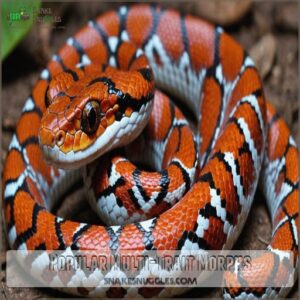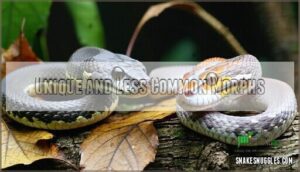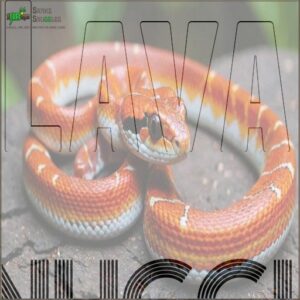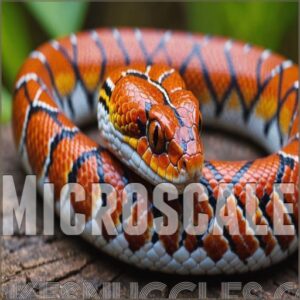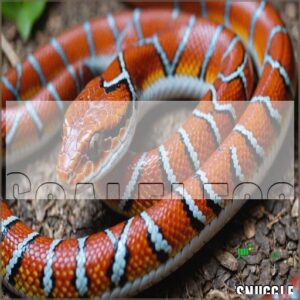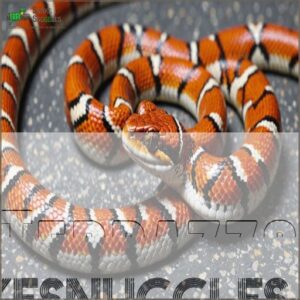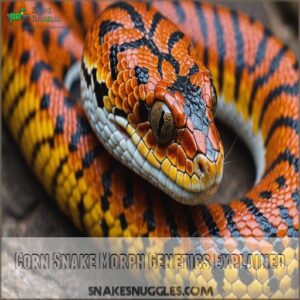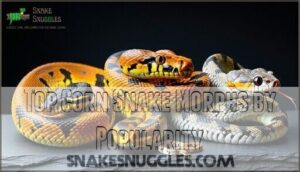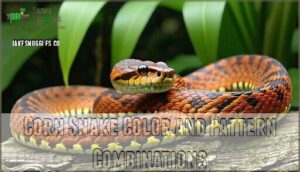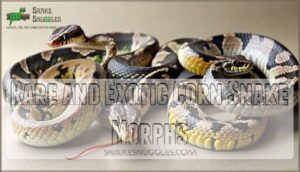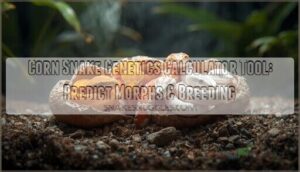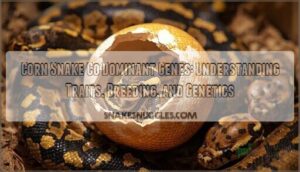This site is supported by our readers. We may earn a commission, at no cost to you, if you purchase through links.
 You’ll find corn snake colors and patterns incredibly diverse! From the classic zig-zag of the normal corn snake to the vibrant reds of the Okeetee locality, there’s a stunning variety. Albino corn snakes boast bright colors, while others, like the Miami locality, sport silvery tones.
You’ll find corn snake colors and patterns incredibly diverse! From the classic zig-zag of the normal corn snake to the vibrant reds of the Okeetee locality, there’s a stunning variety. Albino corn snakes boast bright colors, while others, like the Miami locality, sport silvery tones.
Many morphs exist, including the striking Aztec and the unique Palmetto with its white speckles. The Caramel morph offers beautiful browns and golds, and the Charcoal morph showcases various shades of gray.
Understanding these variations opens up a whole world of possibilities. Want to know which morph is best for you? Let’s explore further!
Table Of Contents
- Key Takeaways
- Common Corn Snake Colors
- Localities and Their Characteristics
- Popular Multi-Trait Morphs
- Unique and Less Common Morphs
- Striking and Sought-After Morphs
- Corn Snake Morph Genetics Explained
- Top Corn Snake Morphs by Popularity
- Corn Snake Color and Pattern Combinations
- Rare and Exotic Corn Snake Morphs
- Corn Snake Morphs Price Guide
- Frequently Asked Questions (FAQs)
- Do corn snakes have color morphs?
- What do orange corn snakes look like?
- What color is a scaleless corn snake?
- How do you know if a corn snake is genetic?
- What colors do corn snakes come in?
- What is the rarest corn snake morph?
- What snake is mistaken for a corn snake?
- What are the patterns of snakes?
- How do corn snake morphs affect temperament?
- Which corn snake morphs are best for beginners?
- How do you care for different corn snake morphs?
- Can corn snake morphs interbreed safely?
- Are there ethical concerns with breeding morphs?
- Conclusion
Key Takeaways
- You’ll find corn snakes exhibit a dazzling variety of colors, from the striking reds of Okeetee to the silvery tones of Miami, making them diverse and captivating pets.
- Understanding different corn snake morphs opens up exciting possibilities, allowing you to select from unique patterns like Aztec zigzags or the Palmetto’s white speckles.
- Most morphs originate from recessive traits, giving each one distinct aesthetic charms without affecting their temperament, which remains friendly and easy to handle.
- Whether you’re a beginner or an enthusiast, choosing the right corn snake morph involves considering factors like affordability, uniqueness, and care requirements.
Common Corn Snake Colors
You’re about to start a colorful exploration of common corn snake colors, starting with varieties like the classic Normal and striking Albino.
Each has its unique charm, from the bright reds of the Okeetee locality to the silvery tones of Miami, making corn snakes one of the most diverse and fascinating pets around.
Normal (Carolina, Classic, Wild Type)
Imagine this: the normal corn snake, often called Carolina or Wild Type, is the quintessential classic.
It’s the snake you’d see slithering through a field, showcasing nature’s zig-zag artistry.
Affordable and easy to care for, these wild types are the baseline for corn snake breeding.
This standard variety offers a charming balance between natural beauty and manageable care.
Okeetee Locality
If you fancy a corn snake with striking contrast, the Okeetee locality is your go-to choice.
Famous for its vibrant red saddle markings bordered by black, it sparks a visual delight.
With Okeetee bloodlines like Kathy Love’s and Lee Abbott’s strains, it’s a classic that never goes out of style.
Perfect for enthusiasts wanting a colorful companion.
Miami Locality
Following your exploration of Okeetee’s fiery reds and black-borders, the Miami Locality stands out with its distinct silver or gray tones. It’s like nature’s own palette, with:
- Miami Locality Breeding producing large clutches.
- Miami Locality Hatchlings showcasing vibrant colors.
- Affordable Miami Locality Price for enthusiasts.
- Striking hues, like blood red and fluorescent orange, rivaling the reverse okeetee.
Keys Locality (Rosy Ratsnake)
Moving from Miami’s vibrant hues, you find the Keys Locality, sometimes called the Rosy Ratsnake.
This beauty stands out with reduced black pigment, showcasing a soft silvery or orange tone.
To properly care for this morph, investing in a suitable corn snake enclosure setup is essential.
People often ponder Rosy Ratsnake Distribution and its unique genetics.
If you’re comparing, Rosy Ratsnake vs. Normal morphs reveal subtle differences, revealing more about its care and availability.
Albino (Amelanistic, Amel)
Albino corn snakes, often called Amel, are fascinating due to their bright colors and lack of melanin.
They stand out with striking reds, oranges, and whites.
Interested in Amel care or breeding? Here’s a quick guide:
- Amel Variations: Diverse shades keep things interesting.
Albino corn snakes have a mutation that affects melanin production and are a common sight in many snake collections, learn more about Understanding Albino Snakes.
- Amel History: This mutation is well-documented.
- Amel Price: Generally affordable, they’re a popular choice.
Localities and Their Characteristics
Some corn snake localities showcase fascinating variations.
You’ll find differences in coloration and patterning based on their origin, similar to how milk snakes display blotches.
Understanding locality history helps appreciate these unique traits.
Distribution maps illustrate where these snakes naturally occur.
Breeding localities often influence the traits passed to offspring.
Locality care needs might vary slightly, but generally remain similar across localities.
For example, Miami corn snakes boast bright saddles, while Okeetees are known for their classic red saddles.
These differences, called locality variations, are a big part of what makes corn snakes so interesting.
The unique coloration of Okeetee corn snakes, influenced by localized occurrence and breeding practices, provides a fascinating example. Studying these geographical differences provides a deeper understanding of corn snake genetics and evolution.
Don’t forget to check out distribution maps to see where your snake’s ancestors thrived!
Popular Multi-Trait Morphs
Among corn snakes, multi-trait morphs like Aztec, Palmetto, and Tessera are fan favorites for their unique patterns and colors.
These morphs blend various genetic traits, giving you a stunning variety of snakes with distinctive appearances.
Perfect for enthusiasts looking to expand their collection.
Aztec
Ever been captivated by a corn snake’s zigzag pattern?
The Aztec morph brings wild patterns to life with its dramatic appearance.
It’s more than just looks—breeders love its versatility in creating new variations.
Although prices vary, its unique style makes it a popular choice.
Caring for an Aztec snake isn’t rocket science; just knowledge and a bit of patience.
Palmetto
The Palmetto morph captivates with its striking appearance and incomplete dominant genetics.
As you explore Palmetto care, you’ll discover these corn snakes are mostly white and speckled, making them unique.
Palmetto breeding explores mixing this morph with others for vibrant Palmetto morph combinations.
Occasionally, heterozygous Palmettos resemble hypo variants, sparking debates on Palmetto vs. hypo distinctions.
Tessera
Switching gears from the eye-catching Palmetto, Tessera morphs bring a touch of sophistication to your snake collection.
These patterns are a treat with their thin, dark-edged dorsal stripes.
Here’s why Tessera morphs have fans:
- Patterns: Unique and simple yet striking.
- Breeding: Offers versatile genetic options.
- Price: Typically starts at $75.
Caramel
You’re probably wondering about Caramel morphs, right?
Their neutral brown, gold, and yellow tones aren’t just easy on the eyes but also add value to your collection.
Due to their versatile genetics, they’re a hit in morph combinations like Butter and Amber.
You’ll find Caramel morph care straightforward, making them a favorite for enthusiasts and breeders alike.
Charcoal
Imagine a snake that’s a striking palette of grays!
Charcoal corn snakes are like anerythristic cousins, yet genetically unique.
With these snakes, it’s important to keep a few things in mind:
- Charcoal morph care is simple—just like any corn snake.
- Track charcoal price trends, as they fluctuate.
- Compare charcoal vs. anery to spot differences easily.
Unique and Less Common Morphs
Now, let’s explore some unique corn snake morphs that aren’t as commonly seen.
You’ll discover fascinating variations like the Cinder, with its intriguing red undertones, and the Dilute morph, known for its faded colors.
Cinder (Ashy, Z)
Palmetto, with its fascinating white speckles, sets the stage for the Cinder morph‘s unique allure, much like the Lavender morph’s soft pastel hues that resemble a twilight sky found in other rare morphs.
This morph begins with a charcoal-like appearance, gradually revealing red undertones that add complexity to its pattern.
Cinder’s rare, smoky beauty intrigues snake enthusiasts, making it a valued addition for breeders exploring its genetics and history.
Cinder morph care emphasizes proper housing and diet.
Diffused
Explore the realm of diffused corn snake morphs and you’ll find a unique twist on these popular reptiles.
The Diffused genetics strip away belly checkers and saddle patterns, creating a smooth look.
Morphs like Fire, Granite, and Plasma evolve with maturity, becoming more striking.
They’re not just pets but fascinating examples of nature’s artistry in reptile form.
Dilute
As Diffused corn snakes leave their patterns behind, the Dilute morph awaits, casting a misty veil over its colors.
Imagine this: a unique morph that looks like it’s always in shed.
Curious about its appeal? Explore these aspects:
- Dilute morph genetics create subtle shades.
- Dilute corn snake care remains straightforward.
- Dilute morph value often surprises enthusiasts.
Hypomelanistic (Hypo)
Discover the fascinating world of Hypomelanistic (Hypo) corn snakes, known for their reduced black pigment.
These snakes range from normal-looking to nearly albino, showcasing intriguing Hypo variations.
Breeding Hypo morphs is common, especially in combinations like Phantom and Ghost.
With a fascinating Hypo history, proper Hypo care helps them thrive in captivity, making them a popular choice for enthusiasts.
Kastanie (Chestnut)
Imagine a Kastanie’s vibrant transformation from dull brown hatchlings to stunning adults.
When it comes to their enclosure setup, a proper corn snake bedding is essential for their health and well-being, and you can find a range of options available online, such as at corn snake bedding stores.
Interested in their care? You’ve got three key aspects to keep in mind:
- Kastanie care and feeding: Offer a variety of prey.
- Chestnut breeding techniques: Maintain genetic diversity.
- Morph combos: Combine Kastanies with other morphs for unique snakes.
Understanding these basics can add a splash of excitement to your snake collection.
Striking and Sought-After Morphs
Among corn snakes, some morphs stand out for their unique beauty and rarity, making them highly sought after by enthusiasts.
As you explore these stunning options, you’ll encounter incredible varieties like Lava, Lavender, Microscale, Scaleless, and Terrazzo, each offering its own distinctive charm and appeal.
Lava
So, you’re interested in striking corn snake morphs? Let’s talk Lava! They’re similar to hypos, but with a cool grayish-purple hue.
Lava genetics are fascinating; they often result in stunning Lava morph combos.
Considering Lava care? It’s pretty standard corn snake stuff.
What about the Lava price? It varies, but they’re usually sought after.
Comparing Lava vs hypo? The color difference is key.
Lavender
Lava morphs are amazing, but have you considered Lavender corn snakes?
With their striking pale lavender hue, these snakes bring elegance to your collection.
Lavender genetics offer unique morph combinations like Opal and Orchid.
Their care mirrors other corn snakes, ensuring simplicity for enthusiasts.
As for Lavender price, expect to pay a bit more for this stunning color.
Microscale
Delving into Microscale corn snakes, you’ll discover a unique marvel.
Their smaller scales reveal gaps of bare skin, creating fascinating Microscale patterns.
These rare beauties demand both careful breeding Microscale strategies and thoughtful Microscale care.
Thanks to their intriguing genetics, their value is high, attracting enthusiasts and collectors alike who cherish their distinct appearance and genetic allure.
Scaleless
A scaleless corn snake captures eyes and curiosity with its smooth, shiny skin.
To make sure proper care is provided, research its unique needs, such as requiring a soft-substrate habitat as detailed in the scaleless corn snake guide.
It requires gentle handling to avoid skin damage.
- Breeding and Ethics: Some enthusiasts debate ethics due to its unique look.
- Cost and Availability: They’re pricey, often hard to find, due to high demand.
Terrazzo
The Scaleless morph might intrigue, but the Terrazzo morph invites a different charm with its grainy, almost patternless look.
Known for its unique appearance, Terrazzo snakes often carry a price of $150 or more.
Breeding them requires understanding their subtle traits, adding to their mystique.
Embrace their popularity, noting Terrazzo variations can be enchanting yet uncommon.
Corn Snake Morph Genetics Explained
The genetic mutation heterozygous for anerythrism that creates the lavender corn snake’s unique coloration, a pale lavender-gray with distinctive patterns, is just one example of the fascinating science behind corn snake morphs. Exploring the mesmerizing world of corn snake genetics reveals how morphs like the Scaleless or Lavender achieve their stunning looks.
At the heart of it, you’ll find a mix of multiple genetic traits.
Most morphs result from recessive traits, meaning each parent must carry the gene for it to pop up in offspring.
Ever wondered how those wild colors emerge? It’s all thanks to gene mutations.
Breeding different morphs involves playing with these genetic puzzle pieces.
Morph combinations arise when you blend traits from different snakes, creating new looks.
Plus, corn snakes can hybridize with other species, adding even more spice to the mix.
These snakes carry no extra health risks—just fascinating diversity in their scales.
Top Corn Snake Morphs by Popularity
When exploring corn snake morphs, you’ll discover a fascinating variety that stands out in popularity for their unique colors and patterns.
Let’s take a closer look at the top morphs, where each holds its own charm, from the classic Albino to the striking Scaleless.
Top 10 Corn Snake Morphs
So, you’ve grasped corn snake genetics? Great!
Now, let’s look at the top ten most popular morphs.
These snakes boast stunning colors and patterns, influencing their price and availability.
Albino, Caramel, and Lavender are always in demand, often priced between $40 to $80 for morphs like the Lavender Corn Snake Morph.
Breeding these popular morphs can be lucrative, but remember proper morph care is key.
Rarity impacts price, so research before you buy!
Top 20 Corn Snake Morphs
You’ve marveled at the top 10 morphs.
Now, imagine expanding those options with 10 more colorful favorites.
From Palmetto’s speckles to Tessera’s unique stripe, there’s plenty to ponder.
Consider morph rarity and weigh price trends.
Ethical sourcing guarantees these beauties are responsibly bred, while a handy care guide makes raising them a breeze.
Aren’t these fascinating?
Top 40 Corn Snake Morphs
Rounding out the top 40 morphs, you’ll find some truly unique corn snakes.
These favorites highlight features like morph rarity and breeding ethics.
With future trends in mind, here are some top picks:
- Scaleless – A marvel but needs special care.
- Microscale – Uncommon, pricey, but stunning.
- Palmetto – Delightful speckles.
- Lavender – Gorgeous hues.
Corn Snake Color and Pattern Combinations
You’ll find that corn snake color and pattern combinations can create an impressive variety of unique and stunning appearances.
From solid colors to intricate patterns and multi-trait morphs, each combination offers a fascinating glimpse into the genetic possibilities of these amazing reptiles.
Solid Colors
Exploring the world of corn snakes, solid colors can be as beautiful as the more intricate patterns.
These solid color variations often shine due to their straightforward beauty.
Understanding their color genetics offers insights into easy breeding practices.
Solid morph care is relatively simple, and these snakes can be a cost-effective choice with generally accessible solid morph pricing.
Patterned Morphs
When diving into patterned morphs, you’ll discover corn snakes with incredible designs due to genetic variations.
These variations can offer unique colors and patterns, boosting their morph value in the market.
Consider these eye-catching patterns:
- Stripes: Bold lines running along their bodies.
- Zig-zags: Intricate, broken patterns creating a wild appearance.
- Spots: Dotted patterns for a playful look.
Such patterns add flair to any breeding project, enhancing morph care discussions.
Multi-Trait Combinations
Diving into multi-trait combos, you’ll find fascinating genetics at play.
These snakes boast unique color and pattern combinations, making each one a top pick for enthusiasts.
Consider this:
| Trait Combo | Rarity Level |
|---|---|
| Palmetto/Tessera | Rare |
| Caramel/Charcoal | Uncommon |
| Aztec/Lavender | Unique |
| Scaleless/Diffused | Highly Rare |
| Lava/Hypo | Uncommon |
With such variety, you’re bound to discover a stunning morph that suits your taste.
Rare and Exotic Corn Snake Morphs
Occasionally, you’ll encounter truly unique corn snake morphs. These rare beauties, like the Scaleless or Microscale, result from unusual genetic mutations.
Breeding these snakes requires careful planning and ethical considerations. Conservation efforts are essential to protect these genetic lines. Proper care is essential for these often-delicate animals.
Remember, responsible breeding practices are key to maintaining the health and value of these extraordinary snakes. Understanding the genetics behind these morphs is fascinating, and it helps you appreciate their uniqueness.
The ethics of breeding rare morphs should always be considered. Their value isn’t just monetary; it’s in their contribution to the overall genetic diversity of the species. Learning about these rare morphs adds to the wonder of corn snake keeping.
Corn Snake Morphs Price Guide
Understanding the factors affecting corn snake price range, such as morph-specific price variations, can help you make informed purchasing decisions. Figuring out corn snake prices can be overwhelming, but understanding how morph traits affect value is essential.
You’ll find morphs ranging from budget-friendly options like the Normal for around $40 to rare, high-end varieties that cost a small fortune.
Affordable Morphs
Let’s explore affordable corn snake morphs perfect for newcomers.
These budget-friendly options won’t break the bank yet offer incredible variety.
Consider these three wallet-friendly morphs:
- Normal (Classic): As low as $40, they mimic wild types.
- Albino: Bright without the hefty price, stunning colors.
- Tessera: Costs around $75, known for its striking pattern.
Mid-Range Morphs
Exploring corn snake mid-range morphs becomes an intriguing pursuit, especially if breeding potential and morph care catch your eye.
These snakes boast notable morph value and often feature common combos that enchant enthusiasts.
With their mid-range price, they’re perfect for hobbyists wanting variety without breaking the bank.
Remember, caring for these beauties demands patience and attention to detail.
High-End Morphs
Jumping from mid-range beauties, you might eye high-end morphs next.
If you’re considering bringing home a rare corn snake, make sure to check out the perfect corn snake tank setups.
These gems like the Scaleless and Microscale, command higher prices due to their rarity and breeding complexity.
You’ll want to keep in mind ethical breeding practices and care tips to ensure these snakes thrive.
Their striking patterns and unique genetics make them a collector’s dream, but choose wisely!
Frequently Asked Questions (FAQs)
Do corn snakes have color morphs?
To each their own, corn snakes have unique scale patterns and colors, such as the amelanistic corn snakes that have some dark markings but appear paler overall, as explained in albino corn snakes guide. corn snakes boast a stunning variety of color morphs like albino, lavender, and palmetto.
These morphs, influenced by genetics, offer diverse patterns and hues, catering to collectors and reptile enthusiasts alike.
What do orange corn snakes look like?
Orange corn snakes often display vibrant hues ranging from bright orange to deep reddish-orange, accented with darker saddle markings along their backs.
This striking appearance makes them visually appealing and a popular choice for reptile enthusiasts.
What color is a scaleless corn snake?
Can you believe 20,000 corn snakes are bred annually in the U.S., sporting various looks?
Scaleless ones showcase vibrant colors and patterns, amplified on their smooth skin.
They can be a stunning mix of reds, oranges, or yellows.
How do you know if a corn snake is genetic?
Identifying a corn snake as genetic involves checking for specific traits like color, pattern, and scale types.
Knowing the parents’ genetic background can confirm if the snake carries specific morph traits.
Genetic testing can also confirm if the snake carries specific morph traits.
What colors do corn snakes come in?
Corn snakes display an array of beautiful colors like red, orange, gray, and white.
Varieties include Albino, Okeetee, and Miami, each with unique patterns.
These colors emerge from fascinating genetic traits combining dominant and recessive genes.
What is the rarest corn snake morph?
Scaleless and microscale corn snakes are incredibly rare. Their unique genetics make them highly sought after, but also expensive. These morphs are truly one-of-a-kind! You’ll find them difficult to locate.
What snake is mistaken for a corn snake?
You might mistake a milk snake for a corn snake, thanks to their similar coloration and patterns.
Both snakes have vibrant red, black, and white bands, but milk snakes mimic this to ward off predators.
What are the patterns of snakes?
Snakes display diverse patterns like stripes, blotches, bands, and speckles that help with camouflage or warning signals.
These patterns can vary between species, such as the bold rings on a coral snake or blotchy patches on a python.
How do corn snake morphs affect temperament?
Corn snake morphs don’t affect temperament.
They’re primarily cosmetic, influencing color and pattern.
Expect consistent behaviors across different morphs.
Corn snakes remain docile and manageable, making them ideal for handling and care, regardless of their unique appearance.
Which corn snake morphs are best for beginners?
Beginners should consider the Carolina or Classic morph, known for affordability and ease of care.
These resemble wild corn snakes, making them both familiar and accessible pets.
Their calm demeanor helps new owners learn the ropes comfortably.
How do you care for different corn snake morphs?
Caring for corn snake morphs typically involves creating temperature zones with heating pads or tape to maintain proper basking and ambient temperatures, as described in the albino corn snakes guide. Caring for corn snake morphs involves maintaining consistent temperature, humidity, and clean enclosures.
Offer a secure habitat, provide fresh water, and feed appropriately sized prey.
Remember, morphs have no unique care needs compared to wild types.
Can corn snake morphs interbreed safely?
Most corn snake morphs can interbreed safely as long as both snakes are healthy.
Morphs, such as the vibrant green tree python morphs which display dynamic color changes and shimmering scales under light view green tree python morphs, are genetically diverse, but this diversity doesn’t affect their health or lifespan.
Just make sure they’re kept in the right environment for breeding.
Are there ethical concerns with breeding morphs?
Ethical breeding prioritizes the snake’s health and well-being. Avoid inbreeding, guarantee proper care, and responsibly sell or rehome offspring. It’s all about mindful stewardship.
Conclusion
Exploring the kaleidoscope of corn snake colors and patterns is like opening a treasure chest of nature’s artistry.
With options like the dazzling Albino or the mysterious Charcoal morph, you’ve got countless possibilities for choosing your slithering companion.
Each morph offers unique looks and temperaments, appealing to both new and seasoned snake enthusiasts.
Whether you’re drawn to the shimmering tones of the Caramel or the striking Palmetto, finding the right corn snake is an adventure in itself!



